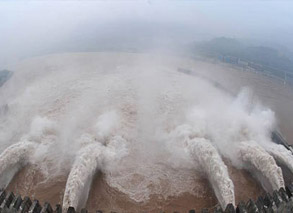U.S. A/H1N1 flu deaths "estimated at 10,000"
2009-12-12 09:22 BJTSpecial Report: World tackles A/H1N1 flu |
BEIJING, December 11 (Xinhuanet) -- A top official has said that an estimated 10,000 people have so far died from the A/H1N1 virus, including some 1,100 children, in the United States in the seven months since its discovery.
"By November 14th, many times more children and younger adults unfortunately have been hospitalized or killed by H1N1 influenza than happens in a usual flu season," Thomas Frieden, head of the Centers for Disease Control and Prevention (CDC) told reporters.
"Specifically, we estimate there have been nearly 50 million cases, mostly in younger adults and children; more than 200,000 hospitalizations... and sadly, nearly 10,000 deaths including 1,100 among children and 7,500 among younger adults," he said.
The number of hospitalizations was around the same as for an entire year when only seasonal flu is circulating, and the estimated death toll, which is based on a new methodology for calculating fatalities from A/H1N1 flu that was rolled out last month, was "much higher than in a usual flu season," said Frieden.
The new way of tallying the number of dead from A/H1N1 flu last month caused the estimated death toll from A/H1N1 flu to soar to 4,000. The toll released just before that count was based on figures provided by 10 states and put the number of swine flu fatalities in the United State at 672 -- and health officials suspected it was a "significant undercount."
There appeared to be some contradiction in the seriousness of the pandemic as painted by U.S medical experts and those in Britain. In a paper published in Britain, the chief medical officer Liam Johnson said that the H1N1 pandemic was "less lethal than expected" and had killed only 26 from every 100,000 who had become ill. A third of those who have died were otherwise healthy individuals and would not have been eligible for the vaccine under current guidelines.
An estimated 540,000 people have contracted the A/H1N1 virus in England and there have been 138 deaths recorded. In spite of the concern for children and young people, there has been a particularly high fatality rate in the oldest age group, just as in previous pandemics.
The over-65s are less likely to get flu, the results show, probably because they have been exposed to other H1N1 viruses in the past, but if they get it, they are at greater risk than most of us. There are low numbers of deaths among the very young (nine in the under-5s, 20 in the under-14s and 17 among 15- to 24-year-olds), which may make it difficult to know how lethal A/H1N1 is proving to them, says the paper published online by the British Medical Journal.
"The 1918-19 pandemic was characterised by high case fatality rates among young healthy adults. There is no evidence of this from our analysis of the current pandemic," the paper says. "Our estimate of the case fatality rate compares favourably with those in the three 20th century influenza pandemics. The rate in the 1918-19 H1N1 pandemic was 2 to 3 percent. Rates in the subsequent pandemics (1957-58 and 1967-68) were in the order of 0.2 percent." The case fatality rate in the current pandemic is 0.026 percent.
There will be many different reasons for this, the study says. Estimates in the past will have been less accurate than they are today and people may have died from other circulating viruses as well as flu. Improvements in the food people eat, their housing and healthcare may also make a difference to survival these days. Modern intensive care treatment is a big factor. "Many more patients might have died in England without the ready availability of critical care support, including mechanical ventilation," it says.
Two thirds of those who died (67 percent) would have been eligible for vaccination if it had been available, the authors say, because of their age or a health problem such as asthma. But that leaves a third who would not have been vaccinated. "Our findings lend support to a vaccination strategy that prioritises high-risk groups. They also show that a substantial minority of deaths are occurring outside these groups. Wider population vaccination therefore merits consideration," they say. Most of those who died (78 percent) were given antiviral drugs (mainly Tamiflu) but only a quarter got them within the necessary 48 hours after symptoms appear.
Confirmed deaths around the world vary considerably from one country to another. In the U.S. the number of confirmed fatalities stands at 2,607, while in Brazil the number is 1,568. Britain records the highest death toll of amongst European countries at 283. In Asia India comes out on top with 675 fatalities and Chinese mainland reports 326 dead from the virus.
Editor: Liu Anqi | Source: Xinhua
 Mail
Mail Share
Share Print
Print


 Video
Video









 2009 China Central Television. All Rights Reserved
2009 China Central Television. All Rights Reserved